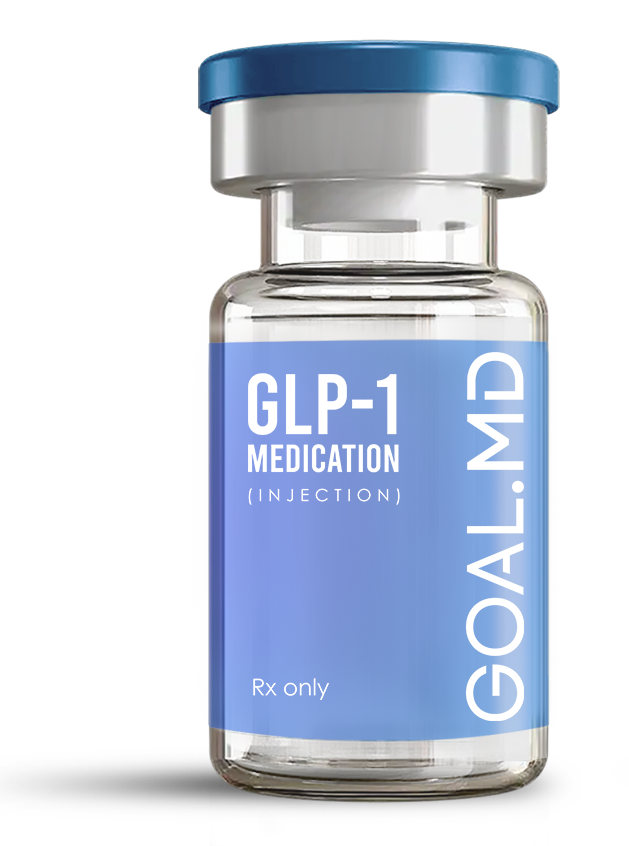
GOAL.MD Health & Wellness Blog
Evidence-based insights, medical weight loss information, and practical tips from our physicians and healthcare experts.

How Fast Can You Lose Weight on GLP-1s?
GLP-1 receptor agonists (e.g., semaglutide/Wegovy or tirzepatide/Mounjaro) are prescription weight-loss medications that mimic a natural gut hormone to curb appetite. In plain terms, these drugs slow your stomach emptying and make you feel full sooner, so you naturally eat less. Under medical supervision and with a healthy diet/exercise, GLP-1s can lead to steady, significant weight loss over time. Crucially, this isn’t an immediate “overnight” fix—results accumulate gradually. Most people notice the first changes within weeks, then continue to progress over months (as shown in trials). Below, we summarize the typical timeline, results, and why consistent dosing matters.
Key Takeaways:
GLP-1s (like Ozempic®, Wegovy®, Mounjaro®, and Zepbound®) tap into hunger signals—they slow gastric emptying and boost fullness.
Early results: average loss of a few percent of body weight in month 1 (often 2–5 lb in 4 weeks). By 3 months, average losses reach roughly 9–10%.
By 6 months on a full dose, many see ~12–15% total loss. Weight-loss effects usually plateau around 9–12 months.
For comparison, standard guidelines aim for ~1–2 lb per week (about 5–10% of weight in 6 months)—GLP-1 results often exceed that when used properly.
Consistency is critical: these drugs are given once weekly. Skipping doses can reverse progress (e.g., after 2 weeks without an injection, appetite rebounds, and weight can return).
Start low and slow: doctors usually begin at ~0.25 mg/week and increase gradually to minimize nausea. Roughly 40–70% of patients experience GI side effects at first (nausea/diarrhoea), but these often ease with time and dose titration.
GLP-1 therapy is typically long-term: most weight loss occurs in the first year, and maintaining losses requires continuing the medication (stopping usually leads to appetite/weight rebound).
How GLP-1s Promote Weight Loss
GLP-1 drugs work by reinforcing your body’s natural satiety signals. In clinical studies, these medications have been shown to:
Slow gastric emptying—food leaves the stomach more slowly, so you feel full longer.
Increase feelings of fullness—the brain’s hunger centers register food intake more strongly.
Suppress appetite—cravings diminish, and you tend to eat fewer calories naturally.
Improve blood sugar control—they boost insulin and lower glucagon (though this is mainly relevant for diabetes, it often coincides with reduced fat storage).
These combined effects mean GLP-1 users often feel satisfied with smaller portions. Over weeks, that reduced intake translates to meaningful weight loss. In practice, patients report not thinking about food as often, wanting sweets less, and feeling full even if they skip a snack or plate cleanings.
Typical Weight-Loss Timeline
Weight loss on GLP-1 therapy unfolds over months. Here’s what research and patient data show (assuming you’re taking the full therapeutic dose, e.g., semaglutide 2.4 mg/week, alongside diet/exercise):
After 1 month (4 weeks): Modest losses. Clinical trials report an average ~3.8% drop in body weight after 4 weeks on semaglutide. That’s roughly 7–8 lb for a 200‑lb person. In real-world practice, many people see 2–5 lb lost in the first month. (Initial weight changes can include fluid shifts, but appetite changes are already noticeable.)
After 3 months: Steady progress. Trial data show ~9.6% loss of baseline weight at 12 weeks. In one real-world study, the median loss was ~6.6% at 3 months. In other words, most people have dropped several percentage points by 3 months (often 5–10% of body weight). This usually means a double-digit pound drop (e.g., 15–20 lb on a 200‑lb person).
After 6 months: Deeper loss. By 6 months, average results are around 12–14% total weight reduction. For example, one study found ~13.6% loss at 6 months on semaglutide. This often translates to dramatic changes—e.g., dropping multiple clothing sizes or losing 30+ pounds, depending on starting weight. It’s common for patients to smile seeing a consistent downward trend on the scale each month.
After 12 months: Plateau around ~15–17%. Clinical reviews report that after one year of semaglutide (with lifestyle change), the average patient has lost about 15–17% of their initial weight. (To put it in perspective, losing ~10% of body weight can improve blood pressure, cholesterol, and blood sugar.) In practice, some people lose more than this (20%+), and others less (e.g., 5–10%), depending on factors like genetics and adherence. Weight tends to level off around 9–12 months—that is, the rate of loss slows as you near your new lower weight.
Example: If you weigh 250 lb, a typical trajectory might be ~10 lb lost in the first month, ~25 lb by 3 months, ~35 lb by 6 months, and ~40–45 lb after a year. These are averages—some lose faster, others slower.
Compared to standard dieting, this is impressive. Health guidelines typically aim for 1–2 lb per week (about 0.5–1% body weight per week), or roughly 5–10% in six months. GLP-1 therapies often double or triple that pace under medical care. Importantly, though, GLP-1 weight loss is not usually linear—you might see faster drops early on, then a slowdown. Plateaus are normal and mean your body is adjusting. Continuing treatment and lifestyle focus usually means maintenance of your loss after the plateau.
Dosing and Why Consistency Matters
To stay on track with GLP-1s, the dosing schedule is critical:
Weekly dosing: Semaglutide and tirzepatide are given as once-weekly injections (some forms are oral pills, but still a daily/weekly routine). You’ll typically start very low (e.g. 0.25 mg/week), and your provider will raise the dose every 3–4 weeks until you reach the full 2.4 mg (for weight loss). This gradual increase helps your body adjust. Don’t try to speed up the titration—higher doses bring more appetite suppression, but only if your body can tolerate them.
Stick to the schedule: If you follow the plan, drug levels in your body stay stable. Semaglutide has a ~1-week half-life, meaning after 5–7 days without a dose the level falls by half. Missing one dose and taking it a few days later is usually okay, but skipping 2 to 3 weeks of injections means the medication essentially leaves your system. In practice, skipping two weekly doses often causes appetite to rebound and can undo lost ground. (UCLA Health notes that after ~14 days without GLP-1, patients may need to restart at a lower dose to avoid strong side effects.)
Side effect management: Gastrointestinal side effects are very common at first—many users experience nausea, vomiting, or diarrhoea. These usually peak in the first few weeks and then fade. To manage them, eat smaller meals, avoid very fatty or spicy foods, and drink plenty of water. Often doctors will hold at a dose until symptoms ease, then continue titration. Over time, most people tolerate the medication well.
Long-term strategy: GLP-1 therapy is typically not a “one-shot” cure. Studies and clinical practice generally involve 1–2 years of treatment. The medication helps you lose weight and learn a new baseline of eating. If you stop the drug, most people’s appetite returns to pre-treatment levels, and some weight will creep back. For this reason, many patients treat it like a long-term plan—losing weight on GLP-1s, then either transitioning to a lower “maintenance” dose or a different strategy under medical guidance.
Patient Experience: The Weight-Loss Journey
Everyone’s journey is unique, but here are common milestones GLP-1 patients report:
Early hunger changes: In weeks 1–2, many patients notice they simply aren’t as hungry. Cravings for sweets or snacks often diminish. People say things like “I don’t even think about having chips anymore” or “I actually feel full by half a plate.” This early appetite drop usually precedes major weight changes.
Initial pounds lost: By the end of the first month, most patients will have lost some weight. It might just be a few pounds (2–5 lb is common), but it’s a start. This initial loss is often a mix of fat, water, and lower calorie intake. Even this amount can be a big psychological boost.
Ongoing weight drop: By 2–3 months, patients often see appreciable changes. Trial data and real-world studies both show that by 3 months, GLP-1 users typically lose on the order of 5–10% of their body weight. For someone at 200 lb, that’s 10–20 lb gone. People might notice looser clothes, compliments from friends, or increased energy in day-to-day life.
Lifestyle synergy: With reduced appetite, patients find it easier to stick to smaller portions and healthier foods. Many incorporate light exercise (walking, yoga, gym classes), which the medication supplements by curbing hunger. The combo of “medicine + lifestyle” is always stronger than the pill alone.
Plateaus and perseverance: Typically by 6–9 months you enter a slower-loss phase. You might go weeks with no change on the scale. This is normal. It often means you’re approaching a new set point. Staying on the medication and perhaps fine-tuning diet (e.g., tracking calories, tweaking macros) can help. During plateaus, doctors often remind patients how far they’ve come—even maintaining a big loss is a win.
Throughout, medical check-ins (like those provided by Goal.MD’s physicians) help manage expectations. Adjusting the nutrition plan, addressing any lingering side effects, and celebrating small victories keep motivation high. Many patients say that after the initial struggle with side effects, they “forgot” about the medication because it just became part of their weekly routine, while only the positive results remained visible (looser belts, better health markers, etc.).
Getting Started with GLP-1 Therapy
If you’re considering GLP-1 medications for weight loss, Goal.MD makes it easy to begin. Their licensed doctors will review your medical history, discuss semaglutide or tirzepatide options, and prescribe a personalised plan if appropriate. You’ll receive your medication (and nutrition coaching) by mail, with regular virtual check-ins to track your progress. Many patients appreciate this expert guidance—studies and patient stories show that having a structured program boosts both safety and results. Ready to see if GLP-1 is right for you? Visit Goal.MD and take the 3-minute eligibility quiz. It’s the first step on your guided weight-loss journey.
Disclaimer: All product and company names, including brand names such as Novo Nordisk or Eli Lilly, are the property of their respective owners. This blog is not affiliated with, endorsed by, or sponsored by any of these companies.
Why GOAL.MD?
✅ Sourced from audited 503a US compounding pharmacies.
✅ Custom dosages adjusted to your needs.
✅ Free consultation + 24/7 support.

How It Works
1. Quiz
90 seconds. No commitment.
2. Consult
Video chat with your GOAL.MD doctor.
3. Deliver
Meds at your door tomorrow.
Transform Your Life with Physician-Directed Care
Join thousands who've found success with physician-directed care. Take our 3-minute quiz to see if medical weight loss is right for you.








